Complex Survey Design and the NIS
Brian Detweiler
April 20, 2018
About me
- University of Nebraska, Omaha
- B.S. Computer Science and Mathematics (2009)
- M.S. Mathematics, Data Science (May, 2018)
- Software Engineer (2004-present)
- Flight Operations, U.S. Army National Guard (2000-2009)




A fun experiment
- Step 1: Pick a random percentage. e.g. 54%, 28%, 77%, etc.
- Step 2: Type that number into Google followed by “of Americans”
- Step 3: Follow rabbit hole for hours

Simple random sample
- Pólya urn model
- With (SRSWR) or Without Replacement (SRSWOR)
- With replacement - makes use of i.i.d. assumption
- Without replacement - not i.i.d. but still exchangeable
- Requires access to the entire population

Sampling design
| Sampling Plan | Design-based inference | Model-based inference |
|---|---|---|
Probability sample |
A |
C |
Model-dependent sample |
B |
D |
Quota sampling |
E |
F |
Convenience sampling |
G |
H |
Snowball sampling |
I |
J |
Peer nomination |
K |
L |
Design effects

Design effects
- “deft”
- Similar to variance inflation factor (VIF)
- Effective sample size
\[ D^2(\hat{\theta}) = \frac{SE(\hat{\theta})^2_{complex}}{SE(\hat{\theta})^2_{srs}} = \frac{var(\hat{\theta})_{complex}}{var(\hat{\theta})_{srs}} \]
\[ n_{eff} = \frac{n_{complex}}{d^2(\hat{\theta})} \]
Clustering
- Grouping people by geographic regions
- SRS to choose a geographic region
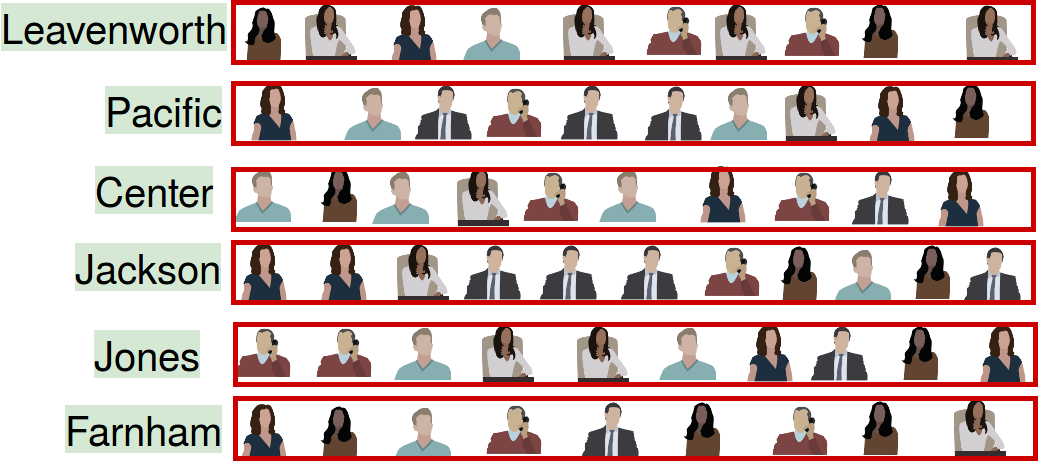
Clustering

Stratification
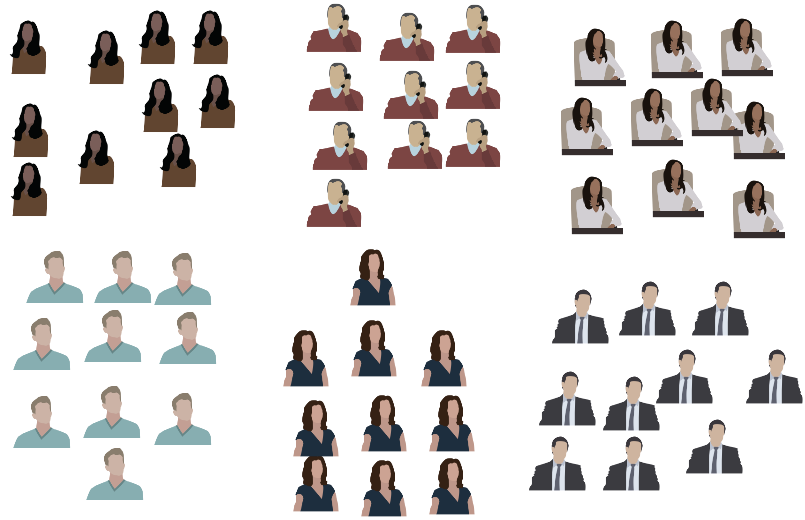
Stratification
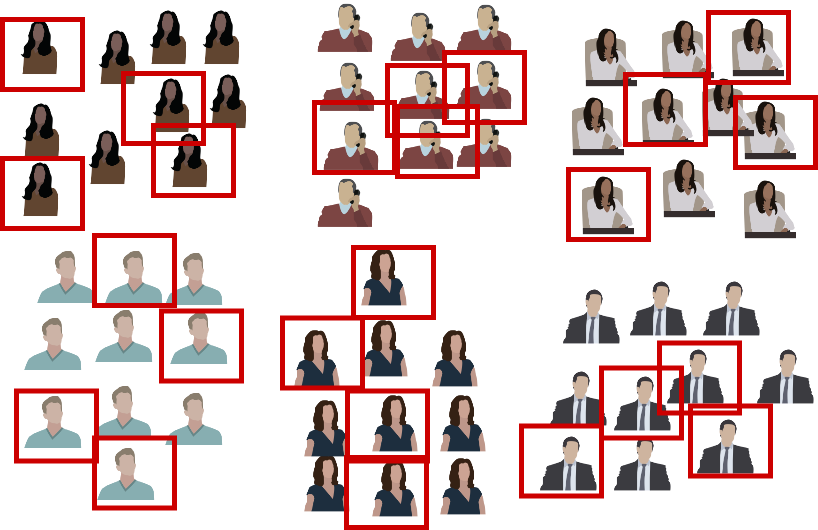
Weighting
- \(N = 51\)

Weighting
- \(N_{men} = 30\)
- \(p_{men} = \frac{30}{51} = 0.588\)

Weighting
- \(N_{women} = 21\)
- \(p_{women} = \frac{21}{51} = 0.412\)
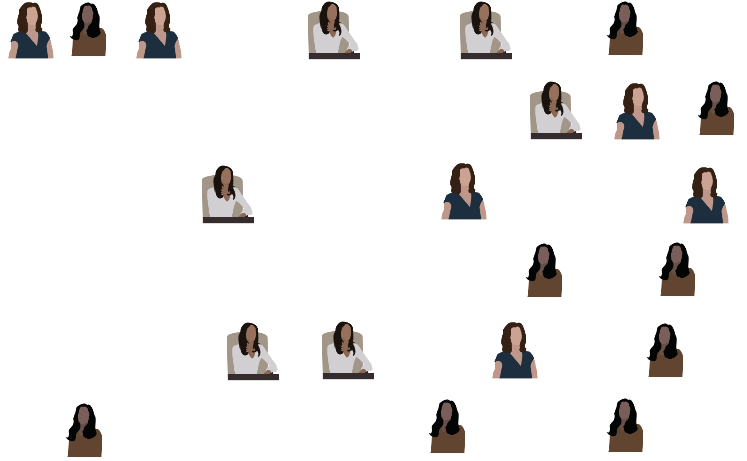
Weighting
- \(N_{women} = 21\)
- Women Odds Ratio: \(\frac{p_{women}}{p_{men}} = \frac{0.588}{0.412} = 1.427\)
- Men Odds Ratio: \(\frac{p_{men}}{p_{women}} = \frac{0.412}{0.588} = 0.701\)
H-CUP Nationwide Inpatient Sample
- Healthcare Cost and Utilization Project
- Must be purchased
NIS Sampling Design
- 1988-2011: 100% sample of 20% of HCUP hospitals
- 2012-present: 20% sample of 100% of HCUP hospitals
NIS Complex Survey Design
- Clustered on hospital ID
- Weights included in
discwtfield for national estimates - 1988-2011: Stratified by census region and bed size
- 2012-present: Stratified by census division and bedside
- Region 1 (Northeast)
- Division 1 (New England) -Division 2 (Mid Atlantic)
- Region 2 (Midwest)
- Division 3 (East North Central)
- Division 4 (West North Central) (incl. Nebraska)
- Region 3 (South)
- Division 5 (South Atlantic)
- Division 6 (East South Central)
- Division 7 (West South Central)
- Region 4 (West)
- Division 8 (Mountain)
- Division 9 (Pacific)
- Region 1 (Northeast)
NIS dimensions
- Big data?
- Definitely large data
- ~3GB per year (raw CSV)
Importance of survey design
- Treating as SRS
summary(lm(los~age, data=cdiff))##
## Call:
## lm(formula = los ~ age, data = cdiff)
##
## Residuals:
## Min 1Q Median 3Q Max
## -14.19 -7.12 -3.98 2.27 349.01
##
## Coefficients:
## Estimate Std. Error t value Pr(>|t|)
## (Intercept) 14.190744 0.187955 75.50 <2e-16 ***
## age -0.043275 0.002687 -16.11 <2e-16 ***
## ---
## Signif. codes: 0 '***' 0.001 '**' 0.01 '*' 0.05 '.' 0.1 ' ' 1
##
## Residual standard error: 13.94 on 73264 degrees of freedom
## Multiple R-squared: 0.003528, Adjusted R-squared: 0.003514
## F-statistic: 259.4 on 1 and 73264 DF, p-value: < 2.2e-16Importance of survey design
- Accounting for survey design with R survey package
library('survey')
cdiff.design <- svydesign(ids = ~hospid, data = cdiff, weights = ~discwt, strata = ~nis_stratum, nest=TRUE)
summary(svyglm(los~age, design=cdiff.design))##
## Call:
## svyglm(formula = los ~ age, design = cdiff.design)
##
## Survey design:
## svydesign(ids = ~hospid, data = cdiff, weights = ~discwt, strata = ~nis_stratum,
## nest = TRUE)
##
## Coefficients:
## Estimate Std. Error t value Pr(>|t|)
## (Intercept) 13.95231 0.55033 25.353 < 2e-16 ***
## age -0.04657 0.00637 -7.311 6.27e-13 ***
## ---
## Signif. codes: 0 '***' 0.001 '**' 0.01 '*' 0.05 '.' 0.1 ' ' 1
##
## (Dispersion parameter for gaussian family taken to be 180.579)
##
## Number of Fisher Scoring iterations: 2SRS vs. complex design
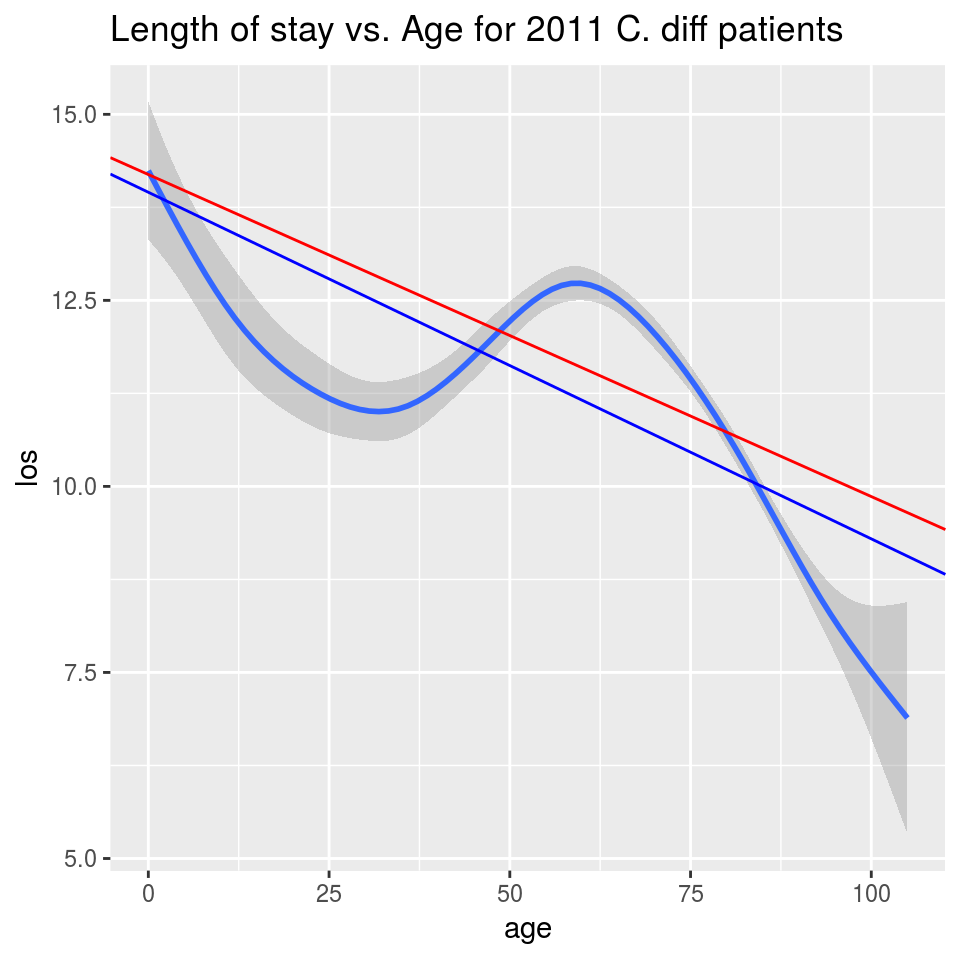
SRS line in red, complex design in blue
Research design checklist
Khera and Krumholz, 2017
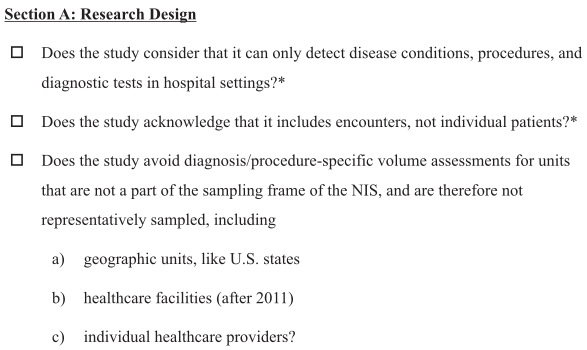
Data interpretation checklist
Khera and Krumholz, 2017

Data analysis checklist
Khera and Krumholz, 2017
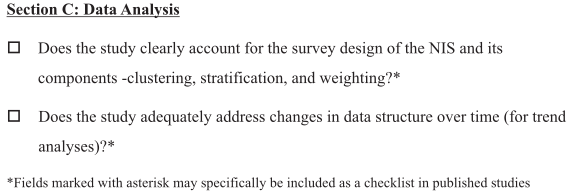
Sources and Further Reading
- Heeringa, S., West, B. T., Berglund, P. A., Applied Survey Data Analysis, 2nd Ed., CRC Press (2017)
- Kalton, G., Introduction to Survey Sampling, SAGE Publications (1983)
- Khera R. and Krumholz H., With Great Power Comes Great Responsibility: Big Data Research From the National Inpatient Sample, Circulation: Cardiovascular Quality and Outcomes (2017)
- Lumley, T. R Package ‘survey’, (2018)